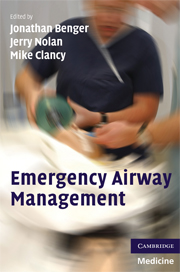Book contents
- Frontmatter
- Contents
- List of contributors
- Foreword
- List of abbreviations
- 1 Introduction and overview
- 2 Delivery of oxygen
- 3 Airway assessment
- 4 Basic airway management techniques
- 5 Indications for intubation
- 6 Preparation for rapid sequence induction and tracheal intubation
- 7 Rapid sequence induction and tracheal intubation
- 8 Pharmacology of emergency airway drugs
- 9 Difficult and failed airway
- 10 Post-intubation management and preparation for transfer
- 11 Emergency airway management in special circumstances
- 12 Non-invasive ventilatory support
- 13 The interface between departments and hospitals
- 14 Audit and skills maintenance
- Appendix: Emergency airway algorithms
- Index
- References
3 - Airway assessment
Published online by Cambridge University Press: 22 August 2009
- Frontmatter
- Contents
- List of contributors
- Foreword
- List of abbreviations
- 1 Introduction and overview
- 2 Delivery of oxygen
- 3 Airway assessment
- 4 Basic airway management techniques
- 5 Indications for intubation
- 6 Preparation for rapid sequence induction and tracheal intubation
- 7 Rapid sequence induction and tracheal intubation
- 8 Pharmacology of emergency airway drugs
- 9 Difficult and failed airway
- 10 Post-intubation management and preparation for transfer
- 11 Emergency airway management in special circumstances
- 12 Non-invasive ventilatory support
- 13 The interface between departments and hospitals
- 14 Audit and skills maintenance
- Appendix: Emergency airway algorithms
- Index
- References
Summary
Objectives
The objectives of this chapter are to:
discuss the rationale for airway assessment
outline a pre-anaesthetic patient assessment
evaluate methods of airway assessment
identify patients who may be difficult to ventilate and/or intubate
identify patients that may require a different airway intervention.
Introduction
During elective anaesthesia a failed airway (‘can't intubate, can't ventilate’) occurs in 0.01–0.03% of cases. Difficult intubation, defined as the need for more than three attempts, occurs in 1.15–3.8% of elective surgical cases, and is usually related to a poor view at laryngoscopy. However, the characteristics of patients requiring intubation or assisted ventilation outside the operating theatre are different to those undergoing elective surgical procedures, and the incidence of difficult intubation is significantly higher in emergency departments. More importantly, a failed airway may occur at least ten times more frequently in the emergency setting: in the United States, 0.5% of intubations recorded in the National Emergency Airway Registry (NEAR) required a surgical airway. In a recent Scottish study, 57/671 (8.5%) of patients undergoing rapid sequence induction in the emergency department had Cormack and Lehane grade 3 or 4 views at laryngoscopy (see below), and two (0.3%) required a surgical airway.
Given these data, difficulties with the airway must be expected in all emergency patients, and appropriate preparation undertaken. Some features may indicate a particularly high likelihood of airway difficulties, and in these cases modification of practice may reduce complications and improve outcome.
Definition of a difficult airway
A difficult airway is categorized by the following.
- Type
- Chapter
- Information
- Emergency Airway Management , pp. 19 - 26Publisher: Cambridge University PressPrint publication year: 2008



